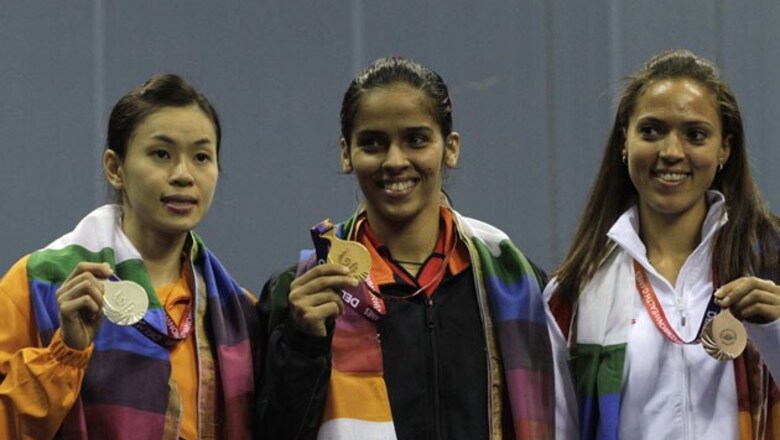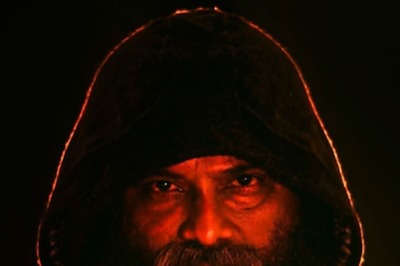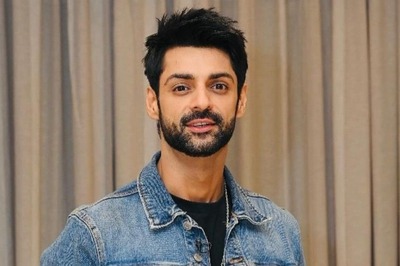
views
New Delhi: Individual brilliance shone through in record-breaking medal hauls at Commonwealth and Asian Games while the iconic Sachin Tendulkar raised the bar further on the cricket field in what turned out to be a golden year for Indian sports.
There were moments of pure ecstasy when the country's athletes notched up 101 medals (including 38 gold) in the Commonwealth Games here and 64 (14 gold) in the Asian Games in Guangzhou. It was the best ever medal haul in both events for a nation which hardly looks beyond cricket on its sporting calendar.
Speaking of India's unofficial national sport, cricket, there were cherishable moments all through 2010 and Tendulkar provided two of the biggest ones by fittingly becoming the first batsman to pull off a double century in one-dayers at the beginning of the year before signing off with another first of recording 50 Test hundreds.
But for a change, cricket and Tendulkar did not matter for at least 14 days in October as India hosted its biggest sporting event after the 1982 Asian Games.
The 19th Commonwealth Games were supposed to showcase India as the next big sporting destination but left fans with mixed feelings after a botched build-up but a historic medal haul.
The athletes were undoubtedly on an unprecedented high at the event in front of home fans but the administrators touched a nadir when they made the country a subject of international mockery with preparations so shoddy that it seemed that top participating nations would give the Games a miss.
In fact, administrators were the only source of embarrassment for Indian sports this year because going by on-field performance, 2010 can easily be counted among the most successful in Indian sporting history.
At the centre of it all was Suresh Kalmadi, the man who has headed the Indian Olympic Association for over a decade and was chairman of the organising committee for the CWG.
The messed build-up to CWG was squarely blamed on him but most importantly he was the focus of an alleged multi-crore scam in CWG deals now being investigated by the CBI.
The veteran administrator claimed innocence but damning evidence, some of it chronicled in national dailies, meant that his houses in Pune and Delhi were raided, adding another low to his chequered career.
The wrangling between the Sports Ministry and National Sports Federations over tenure limitation guidelines was also a messy chapter in Indian sports this year with administrators insisting on unlimited hold on their positions while the government calling for more accountability through time-bound tenures.
The ugly developments, however, could not take the sheen off the massive achievements on the field.
Shuttler Saina Nehwal continued her giant strides, breaking through the 'Great Wall of China' with five international titles to become the world number two in a highly successful 2010.
After a highly promising last year during which she won the Indonesian title, Saina proved once again why she is the brightest star in Indian badminton as she went several steps ahead this year.
The Hyderabadi became the first female Indian shuttler to win three back-to-back titles when she clinched the Indian Open Grand Prix Gold, Singapore Super Series and defended the Indonesian Open in June.
But the icing on the cake came in October when the 20-year-old won the Commonwealth Games gold medal at the Sri Fort Complex.
She didn't stop there and her insatiable hunger for success guided her to a third Super Series title when she won the Hong Kong Open last month to wipe out the disappointment of losing in the quarterfinals of the Asian Games.
Twin honours at the national level added to her aura as she was conferred the Rajiv Gandhi Khel Ratna and Padma Shree awards.
History was also scripted in the swimming pool when a 19-year-old Virdhawal Khade produced a performance to remember by ending Indian swimming's 24-year-old medal drought in the Asian Games, holding out promise for a better future.
The strapping six-footer from Kolhapur clinched a bronze in the 50m butterfly event of the Asian Games in Guangzhou, the India's second swimming medal at the event after Khazan Singh's 200m butterfly.
However, there was disappointment for the Indians in the other multi-discipline sporting extravaganza in Commonwealth Games. The Indian contingent had to bow to Australian, English and Canadian might, even as they advanced to finals in some events.
But even there, para-swimmer Prasanta Karmakar became the first Indian swimmer to fetch a medal by winning a bronze in the 50m freestyle event.
In the boxing ring, the year started with an unprecedented gold rush and ended pretty much the same way as new heights were scaled with Olympic hero Vijender Singh once again leading the charge by clinching two gold medals and a bronze.
The season began with three gold medals in the South Asian Games in Dhaka in February.
Just a month later, the boxers landed half a dozen gold medals with a cracker of a performance in front of adoring home fans in the Commonwealth Championships.
Trading punches in front of crowds that generally don't turn up for non-cricket sporting events in India, Vijender (75kg), South Asian Games gold medallist Amandeep (49kg), Suranjoy (52kg), Asian silver medallist Jai Bhagwan (60kg), Olympian Dinesh Kumar (81kg) and Paramjeet Samota (+91kg) fetched gold to further enhance the sport's rising profile in
the country.
The championship, in fact, was just a prelude to a fantastic performance in the Commonwealth Games that were to follow six months later, again in the capital.
It turned out to be a bitter-sweet campaign in the end with Vijender settling for bronze after a controversial loss in the semifinals and defending champion Akhil Kumar (56kg) signing off without a medal following a quarterfinal defeat.
But Suranjoy, Manoj Kumar (64kg) and Paramjit Samota (+91kg) ensured that Indian boxing pulled off its best-ever performance in the Games history by notching up gold medals.
A month later at the Asian Games, the Indian boxers managed a brilliant haul of two gold, three silver and four bronze medals without showing any sign of fatigue. The twin golds -- bagged by Vijender and 18-year-old Vikas Krishan (60kg) -- were the first after Dingko Singh clinched the yellow metal in 1998.
The men had a consistently good run but in the women's arena it was only 'The Magnificent' M C Mary Kom who made an impression.
The Manipuri mother of two added an unprecedented fifth world championship title to her kitty but the rest of the women boxers flopped at the September event, fetching just a bronze to go with Mary Kom's gold.
At the shooting range, fortunes ebbed and flowed but Indian shooters, led by the mercurial Gagan Narang, experienced more highs than lows in a year that saw them clinch a record 30 medals in the Commonwealth Games.
A measly haul of eight medals in the Asian Games in Guangzhou following the high at home was the only blip in an otherwise satisfactory year.
Apart from Narang, there were quite a few others such as Hariom Singh, Ronjan Sodhi, Asher Noria and Tejaswani Sawant who also caught the attention with their exploits over the last 12 months.
Narang and Hariom won quota places for the London Olympics in 2012, Sodhi won gold in the ISSF World Cup in Turkey before repeating his feat in Guangzhou, while Sawant and junior world champion Noria were the two world record holders of the year.
Courtesy her gold in the World Championship in Munich, Sawant became the first woman shooter from India to win the yellow metal.
In tennis, emergence of a new men's singles hope in Somdev Devvarman and resurgence of an injury-ravaged Sania Mirza were the highlights of a memorable 2010.
The country can now look upon Somdev to be the sport's torchbearer in men's singles while the doubles scene also brightens up with the estranged pair of Leander Paes and Mahesh Bhupathi reuniting next year -- ending a nine-year separation on the ATP circuit.
Being in and out of the top-100 ranking, Somdev reached a career high of 94 this October and justified his growing stature at the international arena.
He ended the year on a perfect note, by becoming the first Indian to win a tennis singles gold medal at the Asian Games.
Some less talked about sports also made a mark.
Indian archers had some hits as well as misses as they became a force to reckon with, ahead of the London Olympics in two years time.
The emergence of 16-year-old Deepika Kumari and the stunning comeback by 2004 Olympian Tarundeep Rai after being in the sidelines for about two years were some high points of 2010.
Daughter of an autorickshaw driver in Ranchi, Deepika was the best performer in the Commonwealth Games when she clinched the gold in individual section and helped the team win another yellow metal.
Asian Games was though a heart-breaking experience for Deepika who faltered to finish fourth in individual section, but the Army archer Tarundeep scripted history by bagging the first ever silver in individual recurve as India also won a bronze medal each in men's and women's team events.
However, the archers bagged just eight medals -- three gold, one silver and four bronze -- of the 24 up for grabs in the CWG.
In cue sports, Pankaj Advani was yet again cynosure of all eyes with his gold medal win at the Guangzhou Asian Games.
But there were disappointments as well.
Dope menace ebbed a bit in weightlifting but the country's lifters produced below-par performances in the two multi-sporting events of the year -- Commonwealth Games and Asian Games -- in which they were allowed to take part only after paying a hefty fine to the international parent body.
The lifters could win just eight medals, including two gold, in the CWG, a far cry from the 27 -- 11 gold, nine silver and seven bronze -- in 2002 Manchester Games and less than the three gold, five silver and a bronze the country won in Melbourne in 2006.
On the football field, it was not smooth sailing on the field but off it there have been many positives for Indian football, especially the AIFF's Rs 700 crore commercial deal with IMG-Reliance that is expected to pave the way for a better future for the sport in the country.
The national team continued with its exposure trips to prepare for the Asian Cup next year, touring Portugal where the players got opportunities to train in world class facilities and play against the second and third division clubs in the Iberian country.
In the final analysis, year 2010 was a roller-coaster ride for Indian sports in which the highs clearly outnumbered the lows.



















Comments
0 comment